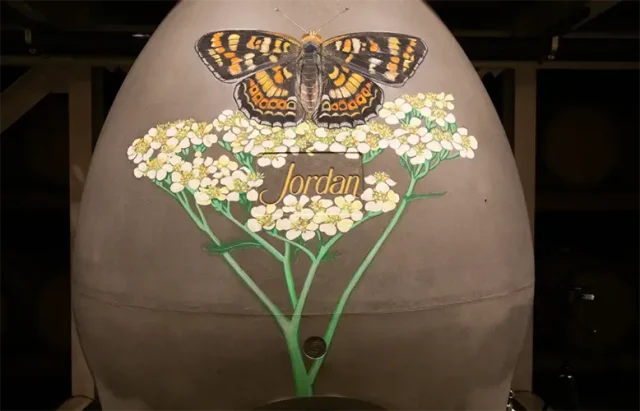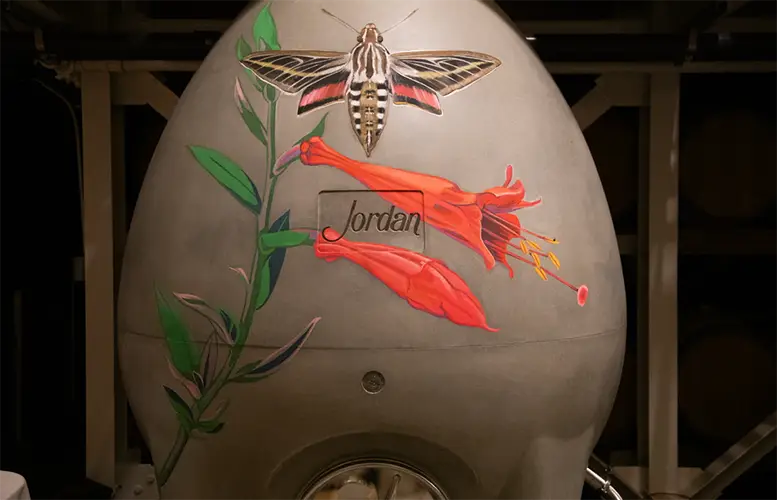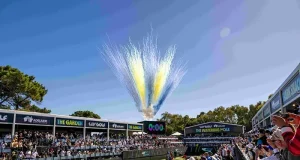
Jordan Vineyard & Winery, the distinguished producer of French-inspired chardonnay and cabernet sauvignon wines in Sonoma County’s wine country, is excited to announce its latest temporary art installation titled, “Pollinator Pairings” by esteemed artist trio, Ink Dwell. Utilizing soft pastel chalk and washable paint tempera on five of Jordan’s concrete eggs used for the Jordan Chardonnay program, the eye-catching installation also conveys an important narrative to visitors. Marking the second annual unveiling of pollinator and endangered species art at Jordan, Ink Dwell’s installation follows last year’s honeybee art installation in partnership with The Good of the Hive.

The ‘Pollinator Pairings’ exhibit sheds light on the importance of essential pollinators within the annual lifecycle of a sustainable, wildlife preserve. With a firm commitment to sustainable farming and land stewardship, Jordan’s estate spans 1,200 acres within the Alexander Valley, with over 75% of the land remaining wild and untouched. Alongside grapevines and olive trees, the estate is a habitat for various animals and insects, such as cows, birds, chickens, butterflies and bees. The winery’s care for the bees is critical, since both native bees and honeybees help to pollinate the lush onsite culinary garden, and pollinator sanctuaries across Jordan’s land contribute to the estate’s dynamic biodiversity.
John Jordan, Chief Executive Officer at Jordan Vineyard & Winery, expressed his enthusiasm for the latest project, stating, “Guests visiting Jordan Winery this spring and summer will undoubtedly find themselves captivated by our new temporary art installation, ‘Pollinator Pairings.’ This artistic endeavor pays tribute to the delicate moths, butterflies and their pollinator plants, carefully cultivated throughout our vast 1,200-acre Jordan Estate. As stewards of our land, caring for the wildlife and their habitat is at the heart of who we are. Each year, we will be sharing a different resident of the Jordan Estate on our unique art canvas, the concrete egg fermenters so guests will have the unique opportunity to experience a new art installation year after year.”

Last April, Jordan Winery was presented the Monarch Sustainer of the Year award by Pollinator Partnership due to the “exceptional leadership and action in providing habitat and awareness for monarchs along their migratory corridors.” During the last few years, Jordan’s agriculture team has planted nearly 10 acres of pollinator plants across its vast estate with the support of Pollinator Partnership, the world’s largest nonprofit dedicated to the protection and promotion of pollinators and their ecosystems. As a certified sustainable winery and a Bee Friendly Farming-certified vineyard, protecting the at-risk Western Monarch Butterfly, native bees and other pollinators is a critical part of Jordan Winery’s land management and sustainability efforts.
Ink Dwell, the artist behind Jordan’s ‘Pollinator Pairings’ installation, is a three-person team led by founder and science illustrator, Jane Kim. Kim’s art is a testament to the boundless beauty of nature and the power of creativity, leading projects from the majestic Wall of Birds at The Cornell Lab of Ornithology to pieces for esteemed institutions like the National Aquarium and the de Young Museum.
“Collaborating with Jordan Winery allows me to integrate my passion for art with their commitment to land stewardship, fostering awareness and appreciation for sustainable practices,” said Jane Kim, Founder and artist at Ink Dwell. “Together, we aim to elevate the dialogue surrounding environmental conservation through art, inspiring others to recognize the interconnectedness between creativity and sustainability. I’m honored to embark on this partnership, furthering the exploration of art as a catalyst for change.” Guests this spring and summer will have the unique opportunity to experience the ‘Pollinator Pairings’ mural during daily Jordan Winery Tours & Tastings. This special, temporary art installation is meant to spark curiosity, conversation and draw attention to the growing threats to pollinators.





